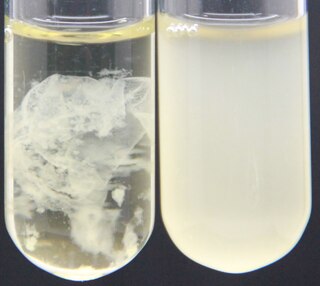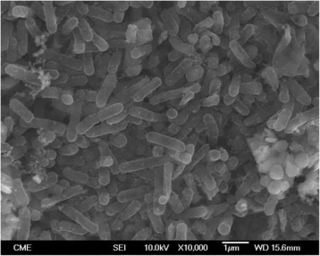
Pseudomonadota is a major phylum of Gram-negative bacteria. Currently, they are considered the predominant phylum within the realm of bacteria. They are naturally found as pathogenic and free-living (non-parasitic) genera. The phylum comprises six classes Acidithiobacillia, Alphaproteobacteria, Betaproteobacteria, Gammaproteobacteria, Hydrogenophilia, and Zetaproteobacteria. The Pseudomonadota are widely diverse, with differences in morphology, metabolic processes, relevance to humans, and ecological influence.
The Rhodocyclaceae are a family of gram-negative bacteria. They are given their own order in the beta subgroup of Pseudomonadota, and include many genera previously assigned to the family Pseudomonadaceae.

The Rhodocyclales are an order of the class Betaproteobacteria in the phylum Pseudomonadota ("Proteobacteria"). Following a major reclassification of the class in 2017, the previously monofamilial order was split into three families:
The Hydrogenophilaceae are a family of the class Hydrogenophilalia in the phylum Pseudomonadota ("Proteobacteria"), with two genera – Hydrogenophilus and Tepidiphilus. Like all Pseudomonadota, they are Gram-negative. All known species are thermophilic, growing around 50 °C, and use molecular hydrogen or organic molecules as their source of electrons to support growth; some species are autotrophs.
Thiobacillus is a genus of Gram-negative Betaproteobacteria. Thiobacillus thioparus is the type species of the genus, and the type strain thereof is the StarkeyT strain, isolated by Robert Starkey in the 1930s from a field at Rutgers University in the United States of America. While over 30 "species" have been named in this genus since it was defined by Martinus Beijerinck in 1904,, most names were never validly or effectively published. The remainder were either reclassified into Paracoccus, Starkeya ; Sulfuriferula, Annwoodia, Thiomonas ; Halothiobacillus, Guyparkeria, or Thermithiobacillus or Acidithiobacillus. The very loosely defined "species" Thiobacillus trautweinii was where sulfur oxidising heterotrophs and chemolithoheterotrophs were assigned in the 1910-1960s era, most of which were probably Pseudomonas species. Many species named in this genus were never deposited in service collections and have been lost.

Acidithiobacillus is a genus of the Acidithiobacillia in the phylum "Pseudomonadota". This genus includes ten species of acidophilic microorganisms capable of sulfur and/or iron oxidation: Acidithiobacillus albertensis, Acidithiobacillus caldus, Acidithiobacillus cuprithermicus, Acidithiobacillus ferrianus, Acidithiobacillus ferridurans, Acidithiobacillus ferriphilus, Acidithiobacillus ferrivorans, Acidithiobacillus ferrooxidans, Acidithiobacillus sulfuriphilus, and Acidithiobacillus thiooxidans.A. ferooxidans is the most widely studied of the genus, but A. caldus and A. thiooxidans are also significant in research. Like all "Pseudomonadota", Acidithiobacillus spp. are Gram-negative and non-spore forming. They also play a significant role in the generation of acid mine drainage; a major global environmental challenge within the mining industry. Some species of Acidithiobacillus are utilized in bioleaching and biomining. A portion of the genes that support the survival of these bacteria in acidic environments are presumed to have been obtained by horizontal gene transfer.

Halothiobacillus is a genus in the Gammaproteobacteria. Both species are obligate aerobic bacteria; they require oxygen to grow. They are also halotolerant; they live in environments with high concentrations of salt or other solutes, but don't require them in order to grow.

Betaproteobacteria are a class of Gram-negative bacteria, and one of the eight classes of the phylum Pseudomonadota.
Thauera is a genus of Gram-negative bacteria in the family Zoogloeaceae of the order Rhodocyclales of the Betaproteobacteria. The genus is named for the German microbiologist Rudolf Thauer. Most species of this genus are motile by flagella and are mostly rod-shaped. The species occur in wet soil and polluted freshwater.

Spirillaceae is a family in the order Nitrosomonadales in the class Betaproteobacteria of the bacteria.
Dechloromonas is a genus in the phylum Pseudomonadota (Bacteria).
Azonexus is a genus of gram-negative, non-spore-forming, highly motile bacteria that is the type genus of the family Azonexaceae which is in the order Rhodocyclales of the class Betaproteobacteria.
Azovibrio is a genus of bacteria from the order Rhodocyclales which belongs to the class of Betaproteobacteria, but the family to which it belongs is uncertain since it falls in between the Zoogloeaceae and the Rhodocyclaceae. Up to now there is only on species known.
Ferribacterium is a genus of bacteria from the family of Rhodocyclaceae which belongs to the class of Betaproteobacteria. Up to now there is only one species of this genus known.
Deferribacter autotrophicus is the most recently discovered species in the Deferribacter genus, isolated from a deep sea hydrothermal field. This motile, thermophilic, anaerobic organism stands out for its unique metabolic versatility, particularly its autotrophic capabilities which had not been previously observed in its genus.
Acidithiobacillus caldus formerly belonged to the genus Thiobacillus prior to 2000, when it was reclassified along with a number of other bacterial species into one of three new genera that better categorize sulfur-oxidizing acidophiles. As a member of the Gammaproteobacteria class of Pseudomonadota, A. caldus may be identified as a Gram-negative bacterium that is frequently found in pairs. Considered to be one of the most common microbes involved in biomining, it is capable of oxidizing reduced inorganic sulfur compounds (RISCs) that form during the breakdown of sulfide minerals. The meaning of the prefix acidi- in the name Acidithiobacillus comes from the Latin word acidus, signifying that members of this genus love a sour, acidic environment. Thio is derived from the Greek word thios and describes the use of sulfur as an energy source, and bacillus describes the shape of these microorganisms, which are small rods. The species name, caldus, is derived from the Latin word for warm or hot, denoting this species' love of a warm environment.

Acidithiobacillus thiooxidans, formerly known as Thiobacillus thiooxidans until its reclassification into the newly designated genus Acidithiobacillus of the Acidithiobacillia subclass of Pseudomonadota, is a Gram-negative, rod-shaped bacterium that uses sulfur as its primary energy source. It is mesophilic, with a temperature optimum of 28 °C. This bacterium is commonly found in soil, sewer pipes, and cave biofilms called snottites. A. thiooxidans is used in the mining technique known as bioleaching, where metals are extracted from their ores through the action of microbes.
Metallosphaera sedula is a species of Metallosphaera that is originally isolated from a volcanic field in Italy. Metallosphaera sedula can be roughly translated into “metal mobilizing sphere” with the word “sedulus” meaning busy, describing its efficiency in mobilizing metals. M. sedula is a highly thermoacidophilic Archaean that is unusually tolerant of heavy metals.
The genus Annwoodia was named in 2017 to circumscribe an organism previously described as a member of the genus Thiobacillus, Thiobacillus aquaesulis - the type and only species is Annwoodia aquaesulis, which was isolated from the geothermal waters of the Roman Baths in the city of Bath in the United Kingdom by Ann P. Wood and Donovan P. Kelly of the University of Warwick - the genus was subsequently named to honour Wood's contribution to microbiology. The genus falls within the family Thiobacillaceae along with Thiobacillus and Sulfuritortus, both of which comprise autotrophic organisms dependent on thiosulfate, other sulfur oxyanions and sulfide as electron donors for chemolithoheterotrophic growth. Whilst Annwoodia spp. and Sulfuritortus spp. are thermophilic, Thiobacillus spp. are mesophilic.
Ann Patricia Wood is a retired British biochemist and bacteriologist who specialized in the ecology, taxonomy and physiology of sulfur-oxidizing chemolithoautotrophic bacteria and how methylotrophic bacteria play a role in the degradation of odour causing compounds in the human mouth, vagina and skin. The bacterial genus Annwoodia was named to honor her contributions to microbial research in 2017.







